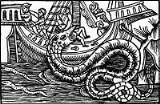
Sea serpent
Encyclopedia
A sea serpent or sea dragon is a type of sea monster
either wholly or partly serpentine.
Sightings of sea serpents have been reported for hundreds of years, and continue to be claimed today. Cryptozoologist Bruce Champagne identified more than 1,200 purported sea serpent sightings. It is currently believed that the sightings can be best explained as known animals such as oarfish
and whale
s. Some cryptozoologists have suggested that the sea serpents are relict
plesiosaurs, mosasaurs or other Mesozoic
marine reptiles, an idea often associated with lake monster
s such as the Loch Ness Monster
.

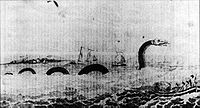 In Norse mythology
In Norse mythology
, Jörmungandr
, or "Midgarðsormr" was a sea serpent so long that it encircled the entire world, Midgard
. Some stories report of sailors mistaking its back for a chain of islands. Sea serpents also appear frequently in later Scandinavian folklore
, particularly in that of Norway
.
In 1028 AD, Saint Olaf
killed and threw onto the mountain Syltefjellet in Valldal, Norway a sea serpent, the marks of which are still visible . In Swedish ecclesiastic and writer Olaus Magnus's
Carta marina
, many marine monsters of varied form, including an immense sea serpent, appear. Moreover, in his 1555 work History of the Northern Peoples, Magnus gives the following description of a Norwegian sea serpent:
Sea serpents were known to sea-faring cultures in the Mediterranean and Near East, appearing in both mythology (the Babylonian Labbu
) and in apparent eye-witness accounts (Aristotle
's Historia Animalium).
In the Aeneid
, a pair of sea serpents killed Laocoön
and his sons when Laocoön argued against bringing the Trojan Horse
into Troy.
and Rahab, from the Hebrew Tanakh
, although 'great creatures of the sea' (NIV) are also mentioned in Book of Genesis 1:21.
In the Book of Amos 9:3 speaks of a serpent to bite the people who try to hide in the sea from God.
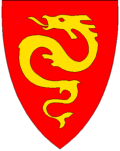



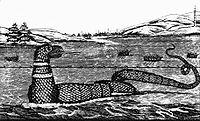
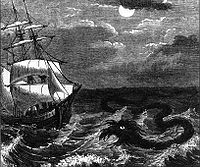


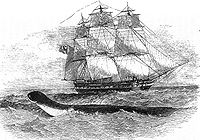
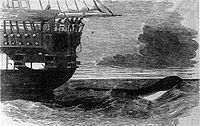
 Hans Egede
Hans Egede
, the national saint
of Greenland
, gives an 18th century descriptions of a sea serpent. On 6 July 1734 his ship sailed past the coast of Greenland when suddenly those on board
Sea serpent sightings on the coast of New England
, are documented beginning in 1638. An incident in August 1817 spawned a rather silly mix-up when a committee of the New England Linnaean Society went so far as to give a deformed terrestrial snake
the name Scoliophis atlanticus, believing it was the juvenile form of a sea serpent that had recently been reported in Gloucester Harbor. The Gloucester Harbor serpent was claimed to have been seen by hundreds of New England residents, including the crews of four whaling boats that reportedly sought out the serpent in the harbor. Rife with political undertones, the serpent was known in the harbor region as "Embargo." Sworn statements made before a local Justice of the Peace and first published in 1818 were never recanted. After the Linnaean Society's misidentification was discovered, it was frequently cited by debunkers as evidence that the creature did not exist.
A particularly famous sea serpent sighting was made by the men and officers of HMS Daedalus in August, 1848 during a voyage to Saint Helena
in the South Atlantic; the creature they saw, some 60 feet (18.3 m) long, held a peculiar maned head above the water. The sighting caused quite a stir in the London papers, and Sir Richard Owen, the famous English biologist
, proclaimed the beast an elephant seal
. Other explanations for the sighting proposed that it was actually an upside-down canoe, or a posing giant squid.
Another sighting took place in 1905 off the coast of Brazil
. The crew of the Valhalla and two naturalists, Michael J. Nicoll and E. G. B. Meade-Waldo, saw a long-necked, turtle headed creature, with a large dorsal fin
. Based on its dorsal fin and the shape of its head, some (such as Heuvelmans) have suggested that the animal was some sort of marine mammal. A skeptical suggestion is that the sighting was of a posing giant squid
, but this is hard to accept given that squids do not swim with their fins or arms protruding from the water.
On April 25, 1977, the Japanese trawler Zuiyo Maru
, sailing east of Christchurch, New Zealand, caught a strange, unknown creature in the trawl. Photographs and tissue specimens were taken. While initially identified as a prehistoric plesiosaur
, analysis later indicated that the body was the carcass of a basking shark
.
, eel
s, basking shark
s, baleen whales, oarfish
, large pinnipeds, seaweed
, driftwood
, flocks of birds, and giant squid
.
While most cryptozoologists recognize that at least some reports are simple misidentifications, they claim that many of the creatures described by those who have seen them look nothing like the known species put forward by skeptics and claim that certain reports stick out. For their part, the skeptics remain unconvinced, pointing out that even in the absence of out-right hoaxes, imagination has a way of twisting and inflating the slightly out-of-the-ordinary until it becomes extraordinary.
A recent posting on the Centre of Fortean Zoology blog by Cryptozoologist Dale Drinnon notes his check of the categories in Heuvelmans' In The Wake of the Sea-Serpents, in which he extracted the mistaken observation categories as a control to check the Sea-serpent categories by using the reports he created identikits for the mistaken observations and enlarged them to possibly 126 of Heuvelmans' sightings, making the mistaken observations the largest section of Heuvelmans' reports. His identikits include oarfish, basking sharks, toothed whales, baleen whales, lines of large whales for the largest Sea-serpent "hump" sightings and trains of smaller cetaceans for the "Many-finned,elephant seals and manta rays. Each of these categories was given a percentage of the whole body of reports, ranging between 1% and 5% with the whales at an average 2.5%, figures which he considers comparable to the regular Sea-serpent categories of Super-eel and Marine Saurian (each of which he breaks into a larger and a smaller sized series following Heuvelmans' suggestion in In the Wake of the Sea-Serpents)
Drinnon has also published in the 2010 CFZ yearbook in which he modifies Coleman's categories (below), adding a possible Giant otter category to the Giant Beavers and modifying several others, bringing the total to 17 categories to broaden the coverage. The broadened coverage allows more instances of conventional fishes such as sturgeons and catfishes, left off Coleman's list.
In a separate and earlier CFZ blog, Drinnon reviewed Bruce Champagne's sea-serpent categories and identified several of them as known animals, and several whales in particular Drinnon basically recognises the Longneck, Marine Saurian and Super-eel categories in this blog as well, with the modification that the Marine Saurian as spoken of by Champagne is more likely a large crocodile akin to C. porosis and that there has been a suggestion that an eel-like animal is involved in certain "Many-finned" observations. The whale categories he identifies are: BC 2A-Possible Odobenocetops, BC2B, Atlantic gray whale or Scrag Whale, BC 4B, as being similar to an unidentified large-finned beaked whale otherwise reported in the Pacific, and BC 5, the large Father-of-All-the-Turtles, as a humpback whale turned turtle.
Sea monster
Sea monsters are sea-dwelling mythical or legendary creatures, often believed to be of immense size.Marine monsters can take many forms, including sea dragons, sea serpents, or multi-armed beasts. They can be slimy or scaly and are often pictured threatening ships or spouting jets of water...
either wholly or partly serpentine.
Sightings of sea serpents have been reported for hundreds of years, and continue to be claimed today. Cryptozoologist Bruce Champagne identified more than 1,200 purported sea serpent sightings. It is currently believed that the sightings can be best explained as known animals such as oarfish
Oarfish
Oarfish are large, greatly elongated, pelagic Lampriform fishes comprising the small family Regalecidae. Found in all temperate to tropical oceans yet rarely seen, the oarfish family contains four species in two genera...
and whale
Whale
Whale is the common name for various marine mammals of the order Cetacea. The term whale sometimes refers to all cetaceans, but more often it excludes dolphins and porpoises, which belong to suborder Odontoceti . This suborder also includes the sperm whale, killer whale, pilot whale, and beluga...
s. Some cryptozoologists have suggested that the sea serpents are relict
Relict
A relict is a surviving remnant of a natural phenomenon.* In biology a relict is an organism that at an earlier time was abundant in a large area but now occurs at only one or a few small areas....
plesiosaurs, mosasaurs or other Mesozoic
Mesozoic
The Mesozoic era is an interval of geological time from about 250 million years ago to about 65 million years ago. It is often referred to as the age of reptiles because reptiles, namely dinosaurs, were the dominant terrestrial and marine vertebrates of the time...
marine reptiles, an idea often associated with lake monster
Lake monster
A lake monster or loch monster is a purported form of fresh-water-dwelling megafauna appearing in mythology, rumor, or local folklore, but whose existence lacks scientific support. A well known example is the Loch Ness Monster. Lake monsters' depictions are often similar to some sea monsters...
s such as the Loch Ness Monster
Loch Ness Monster
The Loch Ness Monster is a cryptid that is reputed to inhabit Loch Ness in the Scottish Highlands. It is similar to other supposed lake monsters in Scotland and elsewhere, though its description varies from one account to the next....
.
In mythology


Norse mythology
Norse mythology, a subset of Germanic mythology, is the overall term for the myths, legends and beliefs about supernatural beings of Norse pagans. It flourished prior to the Christianization of Scandinavia, during the Early Middle Ages, and passed into Nordic folklore, with some aspects surviving...
, Jörmungandr
Jörmungandr
In Norse mythology, Jörmungandr , mostly known as Jormungand, orJörmungand , or Midgard Serpent , or World Serpent, is a sea serpent, and the middle child of the giantess Angrboða and the god Loki...
, or "Midgarðsormr" was a sea serpent so long that it encircled the entire world, Midgard
Midgard
Midgard is one of the Nine Worlds and is an old Germanic name for our world and is the home of Humans, with the literal meaning "middle enclosure".-Etymology:...
. Some stories report of sailors mistaking its back for a chain of islands. Sea serpents also appear frequently in later Scandinavian folklore
Scandinavian folklore
Scandinavian folklore is the folklore of Sweden, Norway, Denmark, Iceland, the Faroe Islands, and the Swedish speaking parts of Finland.Collecting folklore began when Gustavus Adolphus of Sweden sent out instructions to all of the priests in all of the parishes to collect the folklore of their area...
, particularly in that of Norway
Norway
Norway , officially the Kingdom of Norway, is a Nordic unitary constitutional monarchy whose territory comprises the western portion of the Scandinavian Peninsula, Jan Mayen, and the Arctic archipelago of Svalbard and Bouvet Island. Norway has a total area of and a population of about 4.9 million...
.
In 1028 AD, Saint Olaf
St. Olaf
-People:* Saint Olaf, King Olaf II of Norway* Saint Olaf of Sweden, King Olof Skötkonung-Institutions:*St. Olaf College, a private, liberal arts college in Northfield, Minnesota*St. Olaf Choir, the a cappella choir of St. Olaf College-Places:...
killed and threw onto the mountain Syltefjellet in Valldal, Norway a sea serpent, the marks of which are still visible . In Swedish ecclesiastic and writer Olaus Magnus's
Olaus Magnus
Olaus Magnus was a Swedish ecclesiastic and writer, who did pioneering work for the interest of Nordic people. He was reported as born in October 1490 in Östergötland, and died on August 1, 1557. Magnus, Latin for the Swedish Stor “great”, is a Latin family name taken personally, and not a...
Carta marina
Carta marina
The Carta marina , created by Olaus Magnus in the 16th century, is the earliest map of the Nordic countries that gives details and placenames...
, many marine monsters of varied form, including an immense sea serpent, appear. Moreover, in his 1555 work History of the Northern Peoples, Magnus gives the following description of a Norwegian sea serpent:
Those who sail up along the coast of Norway to trade or to fish, all tell the remarkable story of how a serpent of fearsome size, 200 feet long and 20 feet wide, resides in rifts and caves outside Bergen. On bright summer nights this serpent leaves the caves to eat calves, lambs and pigs, or it fares out to the sea and feeds on sea nettles, crabs and similar marine animals. It has ellEllAn ell , is a unit of measurement, approximating the length of a man's arm.Several national forms existed, with different lengths, includingthe Scottish ell ,the Flemish ell ,the French ell...
-long hair hanging from its neck, sharp black scales and flaming red eyes. It attacks vessels, grabs and swallows people, as it lifts itself up like a column from the water.
Sea serpents were known to sea-faring cultures in the Mediterranean and Near East, appearing in both mythology (the Babylonian Labbu
Labbu
In Mesopotamian myth Labbu was a lion-serpent sea-dragon, that was killed by the god-king Tishpak, "warrior of the gods". The myth recounting the predations and defeat of this supernatural adversary figure, of which the most familiar is Satan, has Canaanite origins; it appears in two very...
) and in apparent eye-witness accounts (Aristotle
Aristotle
Aristotle was a Greek philosopher and polymath, a student of Plato and teacher of Alexander the Great. His writings cover many subjects, including physics, metaphysics, poetry, theater, music, logic, rhetoric, linguistics, politics, government, ethics, biology, and zoology...
's Historia Animalium).
In the Aeneid
Aeneid
The Aeneid is a Latin epic poem, written by Virgil between 29 and 19 BC, that tells the legendary story of Aeneas, a Trojan who travelled to Italy, where he became the ancestor of the Romans. It is composed of roughly 10,000 lines in dactylic hexameter...
, a pair of sea serpents killed Laocoön
Laocoön
Laocoön the son of Acoetes is a figure in Greek and Roman mythology.-History:Laocoön is a Trojan priest of Poseidon , whose rules he had defied, either by marrying and having sons, or by having committed an impiety by making love with his wife in the presence of a cult image in a sanctuary...
and his sons when Laocoön argued against bringing the Trojan Horse
Trojan Horse
The Trojan Horse is a tale from the Trojan War about the stratagem that allowed the Greeks finally to enter the city of Troy and end the conflict. In the canonical version, after a fruitless 10-year siege, the Greeks constructed a huge wooden horse, and hid a select force of men inside...
into Troy.
In the Bible
The Bible refers to LeviathanLeviathan
Leviathan , is a sea monster referred to in the Bible. In Demonology, Leviathan is one of the seven princes of Hell and its gatekeeper . The word has become synonymous with any large sea monster or creature...
and Rahab, from the Hebrew Tanakh
Tanakh
The Tanakh is a name used in Judaism for the canon of the Hebrew Bible. The Tanakh is also known as the Masoretic Text or the Miqra. The name is an acronym formed from the initial Hebrew letters of the Masoretic Text's three traditional subdivisions: The Torah , Nevi'im and Ketuvim —hence...
, although 'great creatures of the sea' (NIV) are also mentioned in Book of Genesis 1:21.
In the Book of Amos 9:3 speaks of a serpent to bite the people who try to hide in the sea from God.
Notable cases











Hans Egede
Hans Poulsen Egede was a Norwegian-Danish Lutheran missionary who launched mission efforts to Greenland, which led him to be styled the Apostle of Greenland. He established a successful mission among the Inuit and is credited with revitalizing Dano-Norwegian interest in the island after contact...
, the national saint
Saint
A saint is a holy person. In various religions, saints are people who are believed to have exceptional holiness.In Christian usage, "saint" refers to any believer who is "in Christ", and in whom Christ dwells, whether in heaven or in earth...
of Greenland
Greenland
Greenland is an autonomous country within the Kingdom of Denmark, located between the Arctic and Atlantic Oceans, east of the Canadian Arctic Archipelago. Though physiographically a part of the continent of North America, Greenland has been politically and culturally associated with Europe for...
, gives an 18th century descriptions of a sea serpent. On 6 July 1734 his ship sailed past the coast of Greenland when suddenly those on board
"saw a most terrible creature, resembling nothing they saw before. The monster lifted its head so high that it seemed to be higher than the crow's nestCrow's nestA crow's nest is a structure in the upper part of the mainmast of a ship or structure, that is used as a lookout point.This position ensured the best view of the approaching hazards, other ships or land. It was the best device for this purpose until the invention of radar.In early ships it was...
on the mainmast. The head was small and the body short and wrinkled. The unknown creature was using giant fins which propelled it through the water. Later the sailors saw its tail as well. The monster was longer than our whole ship", wrote Egede. (MarešJaroslav MarešIng Jaroslav Mareš is a Czech biologist, traveller and writer.He graduated from The University of Economics in Prague, getting a degree of Ing . He worked for ČSA in Iran and later in Canada...
, 1997)
Sea serpent sightings on the coast of New England
New England
New England is a region in the northeastern corner of the United States consisting of the six states of Maine, New Hampshire, Vermont, Massachusetts, Rhode Island, and Connecticut...
, are documented beginning in 1638. An incident in August 1817 spawned a rather silly mix-up when a committee of the New England Linnaean Society went so far as to give a deformed terrestrial snake
Snake
Snakes are elongate, legless, carnivorous reptiles of the suborder Serpentes that can be distinguished from legless lizards by their lack of eyelids and external ears. Like all squamates, snakes are ectothermic, amniote vertebrates covered in overlapping scales...
the name Scoliophis atlanticus, believing it was the juvenile form of a sea serpent that had recently been reported in Gloucester Harbor. The Gloucester Harbor serpent was claimed to have been seen by hundreds of New England residents, including the crews of four whaling boats that reportedly sought out the serpent in the harbor. Rife with political undertones, the serpent was known in the harbor region as "Embargo." Sworn statements made before a local Justice of the Peace and first published in 1818 were never recanted. After the Linnaean Society's misidentification was discovered, it was frequently cited by debunkers as evidence that the creature did not exist.
A particularly famous sea serpent sighting was made by the men and officers of HMS Daedalus in August, 1848 during a voyage to Saint Helena
Saint Helena
Saint Helena , named after St Helena of Constantinople, is an island of volcanic origin in the South Atlantic Ocean. It is part of the British overseas territory of Saint Helena, Ascension and Tristan da Cunha which also includes Ascension Island and the islands of Tristan da Cunha...
in the South Atlantic; the creature they saw, some 60 feet (18.3 m) long, held a peculiar maned head above the water. The sighting caused quite a stir in the London papers, and Sir Richard Owen, the famous English biologist
Biologist
A biologist is a scientist devoted to and producing results in biology through the study of life. Typically biologists study organisms and their relationship to their environment. Biologists involved in basic research attempt to discover underlying mechanisms that govern how organisms work...
, proclaimed the beast an elephant seal
Elephant seal
Elephant seals are large, oceangoing seals in the genus Mirounga. There are two species: the northern elephant seal and the southern elephant seal . Both were hunted to the brink of extinction by the end of the 19th century, but numbers have since recovered...
. Other explanations for the sighting proposed that it was actually an upside-down canoe, or a posing giant squid.
Another sighting took place in 1905 off the coast of Brazil
Brazil
Brazil , officially the Federative Republic of Brazil , is the largest country in South America. It is the world's fifth largest country, both by geographical area and by population with over 192 million people...
. The crew of the Valhalla and two naturalists, Michael J. Nicoll and E. G. B. Meade-Waldo, saw a long-necked, turtle headed creature, with a large dorsal fin
Dorsal fin
A dorsal fin is a fin located on the backs of various unrelated marine and freshwater vertebrates, including most fishes, marine mammals , and the ichthyosaurs...
. Based on its dorsal fin and the shape of its head, some (such as Heuvelmans) have suggested that the animal was some sort of marine mammal. A skeptical suggestion is that the sighting was of a posing giant squid
Giant squid
The giant squid is a deep-ocean dwelling squid in the family Architeuthidae, represented by as many as eight species...
, but this is hard to accept given that squids do not swim with their fins or arms protruding from the water.
On April 25, 1977, the Japanese trawler Zuiyo Maru
Zuiyo Maru
The Zuiyo-maru carcass is a creature initially claimed to be a prehistoric plesiosaur that was caught by the Japanese fishing trawler off the coast of New Zealand in 1977...
, sailing east of Christchurch, New Zealand, caught a strange, unknown creature in the trawl. Photographs and tissue specimens were taken. While initially identified as a prehistoric plesiosaur
Plesiosaur
Plesiosauroidea is an extinct clade of carnivorous plesiosaur marine reptiles. Plesiosauroids, are known from the Jurassic and Cretaceous Periods...
, analysis later indicated that the body was the carcass of a basking shark
Basking shark
The basking shark is the second largest living fish, after the whale shark. It is a cosmopolitan migratory species, found in all the world's temperate oceans. It is a slow moving and generally harmless filter feeder and has anatomical adaptations to filter feeding, such as a greatly enlarged...
.
Misidentifications
Skeptics and debunkers have questioned the interpretation of sea serpent sightings, suggesting that reports of serpents are misidentifications of things such as cetaceans (whales and dolphins), sea snakesSea Snakes
Sea Snakes were a Canadian indie rock band, formed in 2002 and disbanded in 2005. The band consisted of vocalist and guitarist Jimmy McIntyre, guitarist Kristian Galberg, bassist and saxophonist Jeremy Strachan, keyboardist Shaw-Han Liem and drummer Nathan Lawr.Strachan played in the defunct band...
, eel
Eel
Eels are an order of fish, which consists of four suborders, 20 families, 111 genera and approximately 800 species. Most eels are predators...
s, basking shark
Basking shark
The basking shark is the second largest living fish, after the whale shark. It is a cosmopolitan migratory species, found in all the world's temperate oceans. It is a slow moving and generally harmless filter feeder and has anatomical adaptations to filter feeding, such as a greatly enlarged...
s, baleen whales, oarfish
Oarfish
Oarfish are large, greatly elongated, pelagic Lampriform fishes comprising the small family Regalecidae. Found in all temperate to tropical oceans yet rarely seen, the oarfish family contains four species in two genera...
, large pinnipeds, seaweed
Seaweed
Seaweed is a loose, colloquial term encompassing macroscopic, multicellular, benthic marine algae. The term includes some members of the red, brown and green algae...
, driftwood
Driftwood
Driftwood is wood that has been washed onto a shore or beach of a sea or river by the action of winds, tides, waves or man. It is a form of marine debris or tidewrack....
, flocks of birds, and giant squid
Giant squid
The giant squid is a deep-ocean dwelling squid in the family Architeuthidae, represented by as many as eight species...
.
While most cryptozoologists recognize that at least some reports are simple misidentifications, they claim that many of the creatures described by those who have seen them look nothing like the known species put forward by skeptics and claim that certain reports stick out. For their part, the skeptics remain unconvinced, pointing out that even in the absence of out-right hoaxes, imagination has a way of twisting and inflating the slightly out-of-the-ordinary until it becomes extraordinary.
A recent posting on the Centre of Fortean Zoology blog by Cryptozoologist Dale Drinnon notes his check of the categories in Heuvelmans' In The Wake of the Sea-Serpents, in which he extracted the mistaken observation categories as a control to check the Sea-serpent categories by using the reports he created identikits for the mistaken observations and enlarged them to possibly 126 of Heuvelmans' sightings, making the mistaken observations the largest section of Heuvelmans' reports. His identikits include oarfish, basking sharks, toothed whales, baleen whales, lines of large whales for the largest Sea-serpent "hump" sightings and trains of smaller cetaceans for the "Many-finned,elephant seals and manta rays. Each of these categories was given a percentage of the whole body of reports, ranging between 1% and 5% with the whales at an average 2.5%, figures which he considers comparable to the regular Sea-serpent categories of Super-eel and Marine Saurian (each of which he breaks into a larger and a smaller sized series following Heuvelmans' suggestion in In the Wake of the Sea-Serpents)
Drinnon has also published in the 2010 CFZ yearbook in which he modifies Coleman's categories (below), adding a possible Giant otter category to the Giant Beavers and modifying several others, bringing the total to 17 categories to broaden the coverage. The broadened coverage allows more instances of conventional fishes such as sturgeons and catfishes, left off Coleman's list.
In a separate and earlier CFZ blog, Drinnon reviewed Bruce Champagne's sea-serpent categories and identified several of them as known animals, and several whales in particular Drinnon basically recognises the Longneck, Marine Saurian and Super-eel categories in this blog as well, with the modification that the Marine Saurian as spoken of by Champagne is more likely a large crocodile akin to C. porosis and that there has been a suggestion that an eel-like animal is involved in certain "Many-finned" observations. The whale categories he identifies are: BC 2A-Possible Odobenocetops, BC2B, Atlantic gray whale or Scrag Whale, BC 4B, as being similar to an unidentified large-finned beaked whale otherwise reported in the Pacific, and BC 5, the large Father-of-All-the-Turtles, as a humpback whale turned turtle.
Classification systems
Cryptozoologists have argued for the existence of sea serpents by claiming that people report seeing similar things, and further arguing that it is possible to classify sightings into different "types". There have been different classification attempts with different results, although they share some common characteristics.Anthonie Cornelis Oudemans
- Megophias megophias : A large sea lion-like creature with a long neck and long tail. Over 200 feet (61 m) long. Only the male has a mane. It is cosmopolitan.
Bernard Heuvelmans
- Long Necked or Megalotaria longicollis: A 60 feet (18.3 m), long necked, short tailed sea lion. Hair and whiskers reported. Cosmopolitan.
- Merhorse or Halshippus olai-magni: A 60 feet (18.3 m), medium necked, large eyed, horse-headed pinniped. Often has whiskers. It is also cosmopolitan.
- Many-Humped or Plurigibbosus novae-angliae: A 60 –, medium necked, long bodied archaeocete. It has a series of humps or a crest on the spine like a sperm whaleSperm WhaleThe sperm whale, Physeter macrocephalus, is a marine mammal species, order Cetacea, a toothed whale having the largest brain of any animal. The name comes from the milky-white waxy substance, spermaceti, found in the animal's head. The sperm whale is the only living member of genus Physeter...
's or grey whale's. It only lives in the North Atlantic. - Super Otter or Hyperhydra egedei: A 65 –, medium necked, long bodied archeocete that resembles an otter. It moves in numerous vertical undulations (6-7). Lived near Norway and Greenland, and presumed to be extinct by Heuvelmans.
- Many Finned or Cetioscolopendra aeliani: A 60 –, short necked archeocete. It has a number of lateral projections that look like dorsal fins, but turned the incorrect way. Compare to the armor on DesmatosuchusDesmatosuchusDesmatosuchus is an extinct genus of archosaur belonging to the Order Aetosauria. It was one of the largest aetosaurs, being long and about 1.50 m high. It lived during the Late Triassic in Texas....
, but much more prominent. - Super Eels: A group of large and possibly unrelated eels. Partially based on the Leptocephalus giganteus larvae, later shown to be normal sized. [This is a controversial identification of a larval specimen made without benefit of actually examining the specimen. This "identification" was done by the paperwork and the actual specimen was missing by then.] Heuvelmans theorized eelEelEels are an order of fish, which consists of four suborders, 20 families, 111 genera and approximately 800 species. Most eels are predators...
, synbranchid, and elasmobranch identities as being possible. Cosmopolitan. - Marine Saurian: A 50 – crocodile, or crocodile-like animal (MosasaurMosasaurMosasaurs are large extinct marine lizards. The first fossil remains were discovered in a limestone quarry at Maastricht on the Meuse in 1764...
, PliosaurPliosaurPliosauroidea is an extinct clade of marine reptiles. Pliosauroids, also commonly known as pliosaurs, are known from the Jurassic and Cretaceous Periods. The pliosauroids were short-necked plesiosaurs with large heads and massive toothed jaws. These swimming reptiles were not dinosaurs but distant...
, etc.) - Yellow Belly: A very large, 100 – yellow and black striped tadpole-shaped creature. Dropped.
- Father-of-all-the-turtles: A giant turtle. Dropped.
- Giant Invertebrates: Giant Venus's girdleCtenophoreThe Ctenophora are a phylum of animals that live in marine waters worldwide. Their most distinctive feature is the "combs", groups of cilia that they use for swimming, and they are the largest animals that swim by means of cilia – adults of various species range from a few millimeters to in size...
and salpSalpA salp or salpa is a barrel-shaped, planktonic tunicate. It moves by contracting, thus pumping water through its gelatinous body...
colonies. Added. It is not clear if Heuvelmans intended them to be unknown species or extreme forms of known species.
Loren Coleman and Patrick Huyghe
- Classic Sea Serpent: A quadrupedal, elongated animal with the appearance of many humps when swimming. Essentially a composite of the many humped, super otter, and super eels types. The authors suggest Basilosaurus as a candidate, or possibly Remingtoncetids.
- Waterhorse: A large pinniped, similar to the long necked and merhorse. Only the males are maned, but females appear to have snorkels. Both of their eyes are rather small. They are noteworthy for being behind both salt and fresh water sightings.
- Mystery Cetacean: A category of unknown whale species including double finned whales and dolphins, dorsal finned sperm whales, unknown beaked whales, an unknown orca, and others.
- Giant Shark: A surviving megalodonMegalodonThe megalodon and ὀδούς ) is an extinct species of shark that lived roughly from 28 to 1.5 million years ago, during the Cenozoic Era .The taxonomic assignment of C...
. - Mystery Manta: A small manta ray with dorsal markings.
- Great Sea Centipede: Same as the many finned. The authors suggest the flippers may either be retractile, and the "scaly" appearance could be caused by parasites.
- Mystery Saurian: Same as the marine saurian.
- Cryptic Chelonian: A resurrection of the father-of-all-turtles.
- Mystery Sirenian: Late surviving Steller's Sea Cow.
- Giant OctopusSt. Augustine MonsterThe St. Augustine Monster is the name given to a large unidentified carcass, originally postulated to be the remains of a gigantic octopus, that washed ashore on the United States coast near St. Augustine, Florida, in 1896. It is sometimes referred to as the Florida Monster or St. Augustine Giant...
, Octopus giganteus or Otoctopus giganteus: A large cephalopod living in the tropical Atlantic.
Bruce Champagne
- 1A Long Necked: A 30 feet (9.1 m) sea lion with a long neck and long tail. The neck is the same thickness or smaller than the head. Hair reported. It is capable of travel on land. Cosmopolitan.
- 1B Long Necked: Similar to the above type but over 55 feet (16.8 m) long and far more robust. The neck is of lesser thickness than the head. Only inhabits water near Great Britain and Denmark.
- 2A Eel-Like: A 20 – long heavily scaled or armored reptile. It is distinguished by a small square head with prominent tusks. "Motorboating" behavior on surface. Inhabits only the North Atlantic.
- 2B Eel-Like: A 25 – beaked whaleBeaked whaleBeaked whales are 21 species of toothed whales, members of the family Ziphiidae, are notable for their elongated beaks. Beaked whales are one of the world's most extreme divers. They can dive for long periods—20 to 30 minutes is common, and 85 minute dives have been recorded—and to...
. It is distinguished by a tapering head and a dorsal crest. "Motorboating" behavior engaged in. Inhabits the Atlantic and Pacific. Possibly extinct. - 2C Eel-Like: A 60 –, elongated reptile with no appendages. The head is very large and cow-like or reptilian with teeth similar to a crabeater seal's. Also shares the "motorboating" behavior. Inhabits the Atlantic, Pacific, and South China Sea. Possibly extinct.
- 3 Multi-Humped: 30 – long. A possible reptile with a dorsal crest and the ability to move in several undulations. The head has a distinctive "camelCamelA camel is an even-toed ungulate within the genus Camelus, bearing distinctive fatty deposits known as humps on its back. There are two species of camels: the dromedary or Arabian camel has a single hump, and the bactrian has two humps. Dromedaries are native to the dry desert areas of West Asia,...
oid" appearance. Identical with Cadborosaurus willsiCadborosaurus willsi"Cadborosaurus willsi", nicknamed Caddy, is an alleged sea serpent reported to be living on the Pacific Coast of North America. Its name is derived from Cadboro Bay in Victoria, British Columbia, and the Greek root word "saurus" meaning lizard or reptile...
. - 4A Sailfin: A 30 – beaked whale. It is distinguished by a very small head and a very large dorsal fin. Only found in the North West Atlantic. Possibly extinct.
- 4B Sailfin: An elongated animal of possible mammalian or reptilian identity reported to be 12 – long. It has a long neck with a turtle-like head and a long continuous dorsal fin. Cosmopolitan.
- 5 Carapaced: A large turtle or turtle-like creature (mammal?) reported to be 10 – long. Carapace is described as jointed, segmented, and plated. May exhibit a dorsal crest of "quills" and a type of oily hair. Cosmopolitan.
- 6 Saurian: A large and occasionally spotted crocodile or crocodile-like creature up to 65 feet (19.8 m) long. Found in the Northern Atlantic and Mediterranean.
- 7 Segmented/Multi limbed: An elongated mammalian creature up to 65 feet (19.8 m) long with the appearance of segmentation and many fins. Found in the Western Atlantic, Indian, and Pacific.
See also
- NāgaNagaNaga or NAGA may refer to:* Nāga, a group of serpent deities in Hindu and Buddhist mythology.-People:* Nayan / Nayar/Nair people of Kerala Society* Naga people, a diverse ethnic identity in Northeast India...
- LeviathanLeviathanLeviathan , is a sea monster referred to in the Bible. In Demonology, Leviathan is one of the seven princes of Hell and its gatekeeper . The word has become synonymous with any large sea monster or creature...
- LindwormLindwormLindworm in British heraldry, is a technical term for a wingless bipedal dragon often with a venomous bite.-Etymology:In modern Scandinavian languages, the cognate lindorm can refer to any 'serpent' or monstrous...
- Stronsay BeastStronsay BeastThe Stronsay beast was a large, dead carcass or globster that washed ashore on the island of Stronsay , in the Orkney Islands, after a storm on September 25, 1808...
- SelmaSelma (sea serpent)Selma is a sea serpent said to live in the lake Seljordsvatnet in Seljord, Norway. According to most who have seen the supposed creature, Selma resembles a giant eel. The first eyewitness accounts date back to the 18th century....
- KrakenKrakenKraken are legendary sea monsters of giant proportions said to have dwelt off the coasts of Norway and Iceland.In modern German, Krake means octopus but can also refer to the legendary Kraken...
External links
- Video of the oarfish, a creature that inspired the sea serpent mythology.
- The Cryptid Zoo: Sea Serpents

